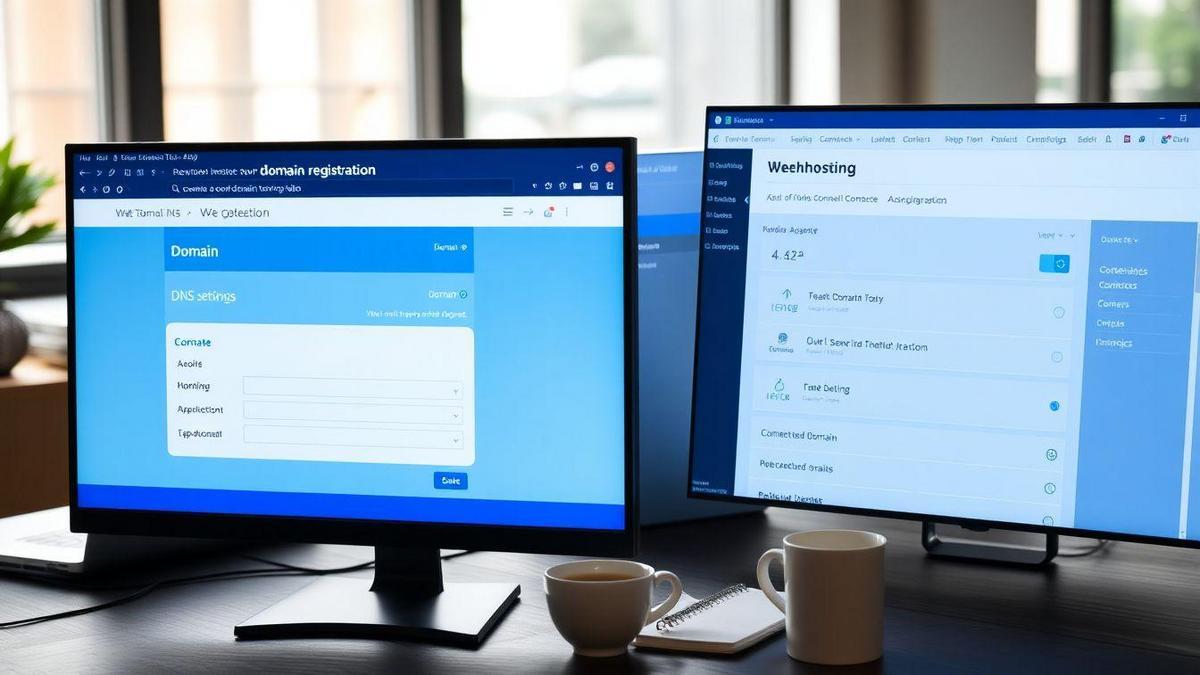Are you eager to learn how to configure DNS and point a domain to hosting? You’re in the right spot! This article will break down the basics of DNS, explain its importance, and guide you step-by-step through managing your DNS settings. Whether you want to fix DNS issues or enhance DNS security, we’ve got you covered. Let’s dive into the world of DNS together!

Understanding DNS Basics
What is DNS and Why is it Important?
DNS stands for Domain Name System. Think of it as the phone book of the internet. Instead of remembering numbers, you remember names. When you type a website name, like www.example.com, DNS helps your computer find the right address to connect to.
Why is this important? Well, without DNS, you’d have to remember a bunch of numbers for every website you want to visit. That would be a headache! DNS makes surfing the web easy and user-friendly. It helps you connect to your favorite sites without the hassle of memorizing complicated IP addresses.
How DNS Works in Simple Terms
Let’s break it down step by step:
- You Type a URL: When you enter a web address in your browser, it sends a request to a DNS server.
- DNS Server Looks it Up: The DNS server searches its records to find the matching IP address for that URL.
- Connection Made: Once the DNS server finds the IP address, it sends it back to your computer. Your browser then uses this address to connect to the website.
Here’s a simple table to show this process:
| Step | Action |
|---|---|
| 1. You Type a URL | Enter www.example.com in your browser |
| 2. DNS Server Looks it Up | Searches for the IP address of example.com |
| 3. Connection Made | Connects your browser to the website |
The Role of DNS in Internet Navigation
DNS is like a friendly guide that helps you find your way around the internet. Imagine trying to find a friend’s house without an address. It would be tough, right? DNS gives you that address, allowing you to reach any site you want quickly and easily.
Without DNS, the internet would be a confusing maze. You’d be lost in a sea of numbers. But thanks to DNS, you can simply enter a name and get where you want to go without a hitch.
Steps to Configure DNS Settings
How to Access Your DNS Settings
Accessing your DNS settings is like finding the key to your digital front door. Here’s how you can do it:
- Log into your hosting account: This is usually where your domain is registered.
- Find the domain management section: Look for options like “Domains” or “DNS Management.”
- Select your domain: Click on the domain name you want to configure.
- Locate DNS settings: This is often labeled as “DNS Records” or “DNS Zone.”
Common DNS Settings You Need to Know
Understanding the common DNS settings is crucial. Here’s a quick rundown of what you’ll encounter:
| DNS Record Type | Purpose |
|---|---|
| A Record | Points your domain to an IP address. |
| CNAME | Redirects one domain to another. |
| MX Record | Manages email delivery for your domain. |
| TXT Record | Provides text information for verification. |
A Quick Guide to DNS Configuration
Configuring your DNS can feel like piecing together a puzzle. Here’s a simple guide to help you get it right:
- Start with A Records: This directs your domain to the right server.
- Add CNAME Records: Use these for subdomains, like www.yourdomain.com pointing to yourdomain.com.
- Set up MX Records: If you want email services, make sure these are in place.
- Include TXT Records: These help with verification for services like Google.
By following these steps, you’ll be well on your way to configuring DNS and pointing a domain to hosting effectively.

How to Point a Domain to Hosting
Understanding Domain Pointing
When you point a domain to hosting, you’re basically telling the internet where to find your website. Think of your domain as the address of your house, and hosting as your house itself. If someone types in your domain, they should arrive at your website. This process involves DNS (Domain Name System) settings.
Step-by-Step Domain Pointing Instructions
Here’s a simple guide to help you point your domain to your hosting:
- Log in to your Domain Registrar: This is where you bought your domain. Examples include GoDaddy, Namecheap, or Google Domains.
- Find the DNS Settings: Look for a section that says DNS Management or Name Server Settings.
- Update Name Servers: You’ll need to replace the current name servers with the ones provided by your hosting provider. They usually look something like this:
- ns1.yourhostingprovider.com
- ns2.yourhostingprovider.com
- Save Changes: After you’ve entered the new name servers, make sure to save your changes.
- Wait for Propagation: It can take anywhere from a few minutes to 48 hours for the changes to take effect.
Here’s a handy table summarizing the steps:
| Step | Action | Notes |
|---|---|---|
| 1 | Log in to Domain Registrar | Use your account credentials |
| 2 | Find DNS Settings | Look for DNS Management |
| 3 | Update Name Servers | Use your hosting provider’s info |
| 4 | Save Changes | Don’t forget this step! |
| 5 | Wait for Propagation | Changes might take time |
Tips for Successful Domain Pointing
- Double-Check Your Entries: A small typo can lead to big problems. Make sure everything is correct.
- Use Reliable Hosting: Choose a hosting provider known for good uptime and support.
- Keep Your Domain Registration Active: If your domain expires, your website will go down.
Pointing your domain might feel like a tricky puzzle, but once you get the hang of it, you’ll see it’s quite straightforward. Just remember, patience is key while waiting for the changes to kick in!
A Record Configuration Explained
What is an A Record?
An A Record is like a treasure map for your website. It points your domain name (like www.yourwebsite.com) to the specific IP address of your server. Think of it as the address label for your website, helping browsers find it on the internet. Without an A Record, your site would be lost in cyberspace!
How to Set Up an A Record
Setting up an A Record is pretty straightforward. Here’s how you can do it step by step:
- Log in to your domain registrar’s account.
- Navigate to the DNS settings or DNS management section.
- Look for the option to add a new record and select A Record.
- Fill in the following details:
- Host: This is usually “@” for your main domain or “www” for a subdomain.
- Points to: Enter the IP address of your hosting server.
- TTL (Time to Live): This is how long the record is cached. You can usually leave this at the default setting.
- Save your changes.
Here’s a simple table to help you visualize it:
| Field | Example Value |
|---|---|
| Host | @ |
| Points to | 192.0.2.1 |
| TTL | 3600 |
Common Mistakes in A Record Configuration
When setting up your A Record, watch out for these common pitfalls:
- Wrong IP Address: Double-check that you’re entering the correct IP address. A tiny mistake can lead to big problems!
- Missing Records: Make sure you have an A Record for both your main domain and any subdomains you want to use.
- Propagation Time: Changes can take a little while to update across the internet. Patience is key here!
By avoiding these mistakes, you’ll be on the right path to getting your website up and running smoothly.

CNAME Setup Made Easy
What is a CNAME Record?
A CNAME record (Canonical Name record) is like a nickname for your domain. It points one domain name to another. So, if you have a website at example.com, you can create a CNAME record to point www.example.com to example.com. This way, both addresses lead to the same place. It’s a handy tool for managing your domains!
How to Create a CNAME Record
Creating a CNAME record is easier than you might think! Here’s a simple step-by-step guide:
- Log in to your domain registrar or DNS hosting provider.
- Find the DNS management section. It might be called “DNS Settings” or “Zone File Settings.”
- Look for an option to add a record.
- Select CNAME from the list of record types.
- Fill in the fields:
- Name: This is what you want to call your CNAME (like www).
- Value: This is the domain you want to point to (like example.com).
- Save your changes!
Here’s a quick table to help you visualize it:
| Field | Description |
|---|---|
| Name | The alias you’re creating |
| Value | The target domain |
Benefits of Using CNAME Records
Using CNAME records comes with some great perks:
- Flexibility: You can easily change where your domain points without changing the main domain.
- Simplified Management: If you have multiple subdomains, a CNAME makes it easy to manage them all.
- SEO Benefits: They can help with search engine optimization by keeping your URLs clean and consistent.
In short, CNAME records are a smart choice for anyone looking to streamline their domain management.
Nameserver Configuration Basics
What are Nameservers?
Nameservers are like the phone book of the internet. When you type a website’s name into your browser, nameservers help translate that name into an IP address, which is what computers use to communicate. Think of it as the middleman that connects you to the website you want to visit. Without nameservers, your browser wouldn’t know where to find the site you’re looking for.
How to Change Your Nameservers
Changing your nameservers is pretty straightforward. Here’s a simple step-by-step guide:
- Log in to your domain registrar: This is where you bought your domain name.
- Find the domain settings: Look for a section called “DNS Management” or “Nameservers.”
- Select the option to change nameservers: You might see a button or link for this.
- Enter the new nameserver information: You’ll usually have at least two nameservers to input.
- Save your changes: Don’t forget to click save or update to make sure your changes stick!
Here’s a quick table to summarize the steps:
| Step | Action |
|---|---|
| 1 | Log in to your registrar |
| 2 | Find domain settings |
| 3 | Select change nameservers |
| 4 | Enter new nameserver details |
| 5 | Save changes |
Importance of Correct Nameserver Settings
Getting your nameserver settings right is super important. If they’re incorrect, your website could go down, and no one would be able to find it. This can lead to lost visitors and potential sales.
Imagine you opened a new restaurant but forgot to put up a sign. No one would know where to go! That’s what happens when your nameservers are wrong. They help guide people to your online space. You want to make sure they point to the right place.

Managing DNS Records Effectively
Types of DNS Records You Should Know
When you dive into the world of DNS records, you’ll find a few key types that are essential for your website. Here’s a quick rundown:
| Type of DNS Record | Purpose |
|---|---|
| A Record | Points your domain to an IP address. |
| CNAME Record | Links one domain to another domain. |
| MX Record | Directs email to the correct mail server. |
| TXT Record | Holds text information, often for verification. |
Understanding these records is crucial for managing your domain and ensuring everything runs smoothly.
How to Edit DNS Records
Editing DNS records might sound tricky, but it’s easier than you think! Here’s how you can do it:
- Log in to your domain registrar: This is where you bought your domain.
- Find the DNS management section: It might be labeled as DNS Settings or DNS Management.
- Choose the record you want to edit: Click on the record type you need to change.
- Make your changes: Update the information as needed.
- Save your changes: Don’t forget this step!
For example, if you want to point your domain to a new hosting provider, you’ll need to change the A record to the new IP address provided by your host.
Best Practices for DNS Records Management
To keep your DNS records tidy and efficient, here are some handy tips:
- Document Changes: Keep a record of what changes you make and why. This helps if you need to troubleshoot later.
- Regularly Review Records: Check your DNS settings every few months to ensure everything is up to date.
- Use TTL Wisely: TTL (Time to Live) controls how long a record is cached. A shorter TTL is good for frequent changes, while a longer TTL is better for stable records.
- Backup Your Records: Before making any major changes, back up your DNS settings. This way, you can restore them if something goes wrong.
Following these practices will help you manage your DNS records like a pro!
Troubleshooting DNS Issues
Common DNS Problems and Solutions
When you’re trying to access a website and it just won’t load, it can be super frustrating. Often, the culprit is a DNS issue. Here are some common problems you might face and how to fix them:
| Problem | Solution |
|---|---|
| Website not found | Check your internet connection. |
| Slow loading times | Clear your browser cache. |
| Incorrect website redirection | Verify DNS settings with your domain registrar. |
| Changes not reflecting | Allow some time for DNS propagation. |
By keeping these solutions in mind, you can tackle most DNS issues head-on.
How to Diagnose DNS Issues
Diagnosing DNS issues can feel like searching for a needle in a haystack. But don’t worry! You can follow a few steps to pinpoint the problem:
- Ping the Domain: Open your command prompt and type ping yourdomain.com. If you get a response, your domain is active.
- Check DNS Records: Use online tools like DNS Checker to see if your DNS records are correct.
- Flush DNS Cache: Sometimes, your computer holds onto old DNS info. You can clear it by typing ipconfig /flushdns in the command prompt.
These steps can help you figure out where the problem lies.
Tools to Help You Troubleshoot DNS
There are many tools out there to help you troubleshoot DNS issues. Here are a few that can make your life easier:
| Tool | Purpose |
|---|---|
| DNS Checker | Check DNS records across multiple servers. |
| Pingdom | Monitor website uptime and performance. |
| DNSPerf | Compare DNS providers’ performance. |
Using these tools can save you time and frustration when you’re trying to figure out what’s wrong.

Importance of DNS Security
Why Secure Your DNS Settings?
Securing your DNS settings is like locking the front door to your home. It keeps unwanted visitors out and protects your valuable information. If your DNS is compromised, hackers can redirect your website traffic to malicious sites, steal sensitive data, or even take your website down. This can lead to loss of trust from your users and serious damage to your brand.
Think of it this way: when you type a website address, your computer asks a DNS server to find the right location. If that server is tampered with, you could end up somewhere you never intended to be. So, keeping your DNS settings safe is crucial to maintaining your online presence.
Tips for Enhancing DNS Security
Here are some simple tips to help you boost your DNS security:
- Use DNSSEC: This adds a layer of verification to your DNS requests, ensuring that the responses come from a trusted source.
- Regularly Update Passwords: Change your DNS account passwords often and use strong, unique passwords.
- Monitor DNS Traffic: Keep an eye on your DNS logs for any unusual activity that could signal an attack.
- Limit Access: Only give DNS access to those who absolutely need it. The fewer people with access, the lower the risk.
- Use a Reliable DNS Provider: Choose a provider known for strong security measures.
| Tip | Description |
|---|---|
| Use DNSSEC | Adds verification to DNS requests |
| Regularly Update Passwords | Change passwords often for added security |
| Monitor DNS Traffic | Watch for unusual activity in your logs |
| Limit Access | Restrict access to trusted individuals only |
| Use a Reliable Provider | Choose a provider with strong security features |
The Impact of DNS Security on Your Website
The impact of DNS security on your website can be significant. A secure DNS means fewer chances of attacks, which leads to a smoother experience for your visitors. If your site is down due to a DNS attack, you could lose traffic and potential customers.
For example, if an e-commerce site experiences a DNS attack, customers may think the site is unreliable and choose to shop elsewhere. This can lead to a loss of sales and damage to your reputation. By investing in DNS security, you’re not just protecting your site; you’re also safeguarding your business and your customers.
Frequently Asked Questions
What do I need to configure DNS for my domain?
You need access to your domain registrar and hosting provider.
How long does it take for DNS changes to take effect?
Usually, it takes a few minutes to 48 hours for changes to update fully.
Can I change my DNS settings anytime?
Yes, you can change your DNS settings anytime you want.
How to configure DNS and point a domain to hosting?
Go to your domain registrar, find DNS settings, and enter your hosting server’s IP address.
What if my website doesn’t work after changing DNS?
Double-check your settings. Ensure you entered the correct IP address.

Lucas is a technical SEO expert who has optimized over 200 websites and managed Google AdSense and Ad Manager campaigns since 2016. At ReviewWebmaster.com, he shares strategies to boost organic traffic and monetize every single visit.
Types of articles he writes:
-
“How to Increase Your Blog’s RPM with Simple Tweaks”
-
“Technical SEO Checklist for WordPress Sites”
-
“Complete Beginner’s Guide to Google Ad Manager”
Why it works:
Lucas brings a confident, analytical, and performance-driven voice to the site — perfect for readers looking for actionable, results-oriented content.
